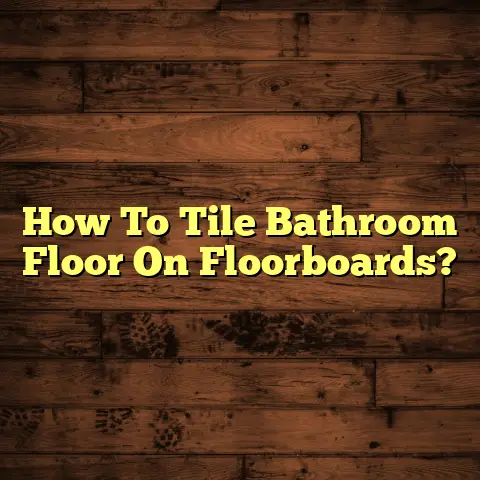Remove Tile Under Cabinets? (1 Trick Installers Use!)
Ever dreamt of a home where the flooring flows seamlessly, creating a stunning, unified look?
I know I have!
We’re living in an era where open-concept designs reign supreme.
And flooring? Well, it’s the unsung hero of these spaces, tying everything together.
But let’s be real, diving into home renovations can feel like navigating a minefield.
Especially when you hit a snag like removing tile under cabinets.
It’s a common headache, and making the wrong move can lead to a domino effect of problems.
That’s why I’m here to share a game-changing trick I’ve learned over years as a flooring contractor.
It’s a technique that can save you time, money, and a whole lot of frustration.
So, grab a coffee, settle in, and let’s explore how to tackle this challenge like a pro!
Section 1: The Challenges of Removing Tile Under Cabinets
Okay, let’s get down to brass tacks.
Why would you even want to remove tile from under your cabinets?
Well, the reasons are as varied as the homeowners I’ve worked with.
Maybe you’re itching for a modern makeover and that outdated tile is cramping your style.
Or perhaps you’ve got cracked or damaged tiles that need replacing.
And sometimes, you’re just looking to install new flooring throughout the entire space.
But here’s the rub: getting to that tile under the cabinets is a beast.
You’re staring down the barrel of potential cabinet damage, awkward angles, and limited space.
It’s like trying to solve a Rubik’s Cube blindfolded!
I remember one client, Sarah, who wanted to replace her kitchen tile with hardwood.
She thought it would be a simple weekend project. Boy, was she wrong!
She ended up chipping the base of her cabinets trying to pry up the tile.
“I thought I could handle it myself,” she told me, “but I quickly realized I was in over my head.”
And Sarah’s not alone.
According to a recent survey by the National Association of Home Builders, kitchen and bath renovations are among the most common, but also the most challenging, home improvement projects.
The tight spaces and existing fixtures make even seemingly simple tasks complicated.
Section 2: Understanding the Importance of Flooring Consistency
Now, let’s talk about why flooring consistency is so darn important.
Think of your flooring as the foundation of your room’s design.
It sets the tone, influences the flow, and impacts the overall aesthetic.
In today’s design landscape, homeowners are craving that seamless, unified look.
They want their flooring to transition smoothly from room to room, creating a sense of spaciousness and harmony.
Gone are the days of choppy, disjointed flooring choices that make a space feel smaller and less cohesive.
We’re seeing a huge surge in popularity for materials like luxury vinyl plank (LVP) and large-format tiles that can be installed throughout the house.
And let’s not forget the impact on home value.
A recent study by Zillow found that homes with updated flooring tend to sell for a higher price and attract more buyers.
Why? Because buyers are looking for move-in-ready homes that don’t require immediate renovations.
So, investing in consistent, high-quality flooring is not just an aesthetic choice, it’s a smart financial one.
Section 3: The One Trick Installers Use
Alright, drumroll please!
It’s time to reveal the secret weapon that professional installers use to tackle the dreaded tile-under-cabinet situation.
The trick?
Utilizing an oscillating multi-tool with a specialized blade to make precise cuts around the cabinet base, effectively isolating the tile for removal without disturbing the cabinetry.
I know, it sounds simple, but trust me, it’s a game-changer.
Here’s a step-by-step breakdown:
-
Prep the Area: Clear out any clutter from around the cabinets and protect the surrounding surfaces with drop cloths or plastic sheeting.
-
Mark the Cut Line: Use a pencil and a straight edge to draw a precise line along the base of the cabinet where you want to cut the tile.
This line will serve as your guide, so make sure it’s accurate and clean.
-
Grab Your Oscillating Multi-Tool: Equip your multi-tool with a grout removal blade or a specialized tile-cutting blade.
These blades are designed to make precise cuts without damaging the surrounding materials.
-
Make the Cut: Carefully guide the multi-tool along the marked line, applying gentle pressure.
Let the tool do the work, and avoid forcing it.
You’ll want to make several passes, gradually cutting through the tile and grout.
-
Remove the Isolated Tile: Once you’ve cut around the perimeter of the tile, use a chisel and a hammer to gently pry it up.
Work slowly and carefully to avoid damaging the cabinet base or the subfloor.
Tools and Materials You’ll Need:
- Oscillating multi-tool
- Grout removal blade or tile-cutting blade
- Pencil
- Straight edge
- Drop cloths or plastic sheeting
- Chisel
- Hammer
- Safety glasses
- Dust mask
Potential Pitfalls to Watch Out For:
-
Dust: Cutting tile generates a lot of dust, so wear a dust mask and consider using a shop vac to keep the area clean.
-
Vibration: The vibration from the multi-tool can loosen the grout in surrounding tiles, so be extra careful when working near existing tile.
-
Blade Selection: Using the wrong blade can damage the tile or the cabinet base, so make sure you choose the right one for the job.
I remember one project where I used this technique to remove tile from under a kitchen island.
The homeowner was thrilled with the results. They saved a ton of money by not having to remove the entire island.
The new flooring looked fantastic, and the kitchen felt completely transformed.
Section 4: Tools and Techniques for DIY Enthusiasts
So, you’re feeling inspired and ready to tackle this project yourself?
Awesome! Here are some tips and tricks to help you nail it like a pro.
Essential Tools:
-
Oscillating Multi-Tool: This is your MVP. Invest in a good quality one with variable speed settings for maximum control.
-
Grout Removal Blade/Tile-Cutting Blade: Experiment with different blades to find the one that works best for your tile type.
-
Safety Gear: Safety glasses and a dust mask are non-negotiable. Protect your eyes and lungs from flying debris and harmful dust.
-
Chisel and Hammer: For gently prying up the isolated tile pieces.
-
Shop Vac: To keep the workspace clean and minimize dust.
Workspace Preparation:
-
Clear the Area: Remove any appliances, furniture, or other items that might get in the way.
-
Protect Surfaces: Cover countertops, cabinets, and other surfaces with drop cloths or plastic sheeting.
-
Ventilate the Room: Open windows and doors to improve airflow and reduce dust buildup.
Techniques and Tips:
-
Practice Makes Perfect: Before you start cutting around the cabinets, practice on a scrap piece of tile to get a feel for the multi-tool and the blade.
-
Go Slow and Steady: Don’t rush the process. Apply gentle pressure and let the tool do the work.
-
Use a Guide: A straight edge or a piece of painter’s tape can help you maintain a clean, straight cut line.
-
Score the Tile First: Before you start cutting, score the tile along the cut line with a utility knife.
This will help prevent chipping and ensure a cleaner cut.
Creative Variations:
-
For Laminate or Vinyl Flooring: You can use a similar technique with a circular saw or a jigsaw to make precise cuts around the cabinet base.
-
For Cabinets with Toe Kicks: You may need to remove the toe kicks to access the tile underneath.
This can be done with a screwdriver or a pry bar.
Section 5: Maintenance and Long-Term Considerations
Okay, you’ve successfully removed the tile from under your cabinets.
Congrats! But the job’s not quite done yet.
It’s important to consider how your tile removal method will impact the long-term maintenance of your flooring.
Here’s what you need to know:
-
Subfloor Preparation: After removing the tile, you may need to prepare the subfloor before installing new flooring.
This might involve patching any holes or imperfections, leveling the surface, or applying a moisture barrier.
-
Material Compatibility: Make sure your new flooring material is compatible with the existing subfloor.
Some materials, like hardwood, require a specific type of subfloor for proper installation.
-
Expansion and Contraction: Different flooring materials react differently to changes in temperature and humidity.
Consider this when choosing your new flooring and leave adequate expansion gaps during installation.
-
Cleaning and Care: Follow the manufacturer’s instructions for cleaning and caring for your new flooring.
Use appropriate cleaning products and avoid harsh chemicals that could damage the surface.
Expert Advice:
-
Consult a Professional: If you’re unsure about any aspect of the project, don’t hesitate to consult a professional flooring contractor.
They can provide valuable advice and ensure that the job is done right.
-
Read the Fine Print: Always read the manufacturer’s instructions for your flooring material before you start the installation process.
This will help you avoid costly mistakes and ensure that your warranty remains valid.
Conclusion
Wow, we’ve covered a lot of ground!
From the challenges of removing tile under cabinets to the innovative trick that installers use, you’re now armed with the knowledge and skills to tackle this project with confidence.
Remember, thoughtful flooring decisions are key to creating a beautiful and functional home.
By using the techniques I’ve shared, you can save time and money while achieving a professional look.
So, go ahead and envision your own spaces transformed through informed flooring choices.
I believe in you!
Call to Action
Now, I’d love to hear from you!
Have you ever tackled a flooring renovation project?
What challenges did you face?
Share your experiences and ask any questions you have in the comments below.
Let’s learn from each other and inspire others to create the homes of their dreams!





